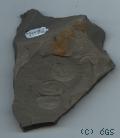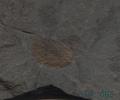Branchiopoda (Branchiopods)
Clam shrimp are a taxon of bivalved branchiopod crustaceans that resemble the unrelated bivalved molluscs. They are extant, and known from the fossil record, from at least the Devonian period and perhaps before. They were originally classified in a single order Conchostraca, which later proved to be paraphyletic (artificial).Both valves of the shell are held together by a strong closing muscle. The animals react to danger by contracting the muscle, so that the valves close tightly and the crustacean, as if dead, lies motionlessly at the bottom of the pool.
In most species the head is dorsoventrally compressed. The sessile compound eyes are close together and located on the forehead; in the genus Cyclestheria they are truly fused. In front of them is a simple naupliar eye. The first pair of antennae is reduced and unsegmented. The second pair of antennae, however, is long and biramous. Both branches are covered with numerous bristles. The crustaceans swim primarily by swooping the antennae. In the common genus Lynceus, which can open its spherical valves wide, the thoracic legs move in an oar-like manner along with the antennae. The number of segments constituting the thorax varies from 10 to 32, and the number of legs varies accordingly. They are similar in structure to the legs of tadpole shrimp, and similarly, their size decreases from front to back. In females, the outer lobes of several middle legs are modified into long, upward-bending threadlike outgrowths, used to hold the eggs on the dorsal side of the body under the shell. However, the main functions of the thoracic legs are respiration and carrying food forward to the mouth. The gills are basically the outer lobes of all thoracic legs that are closest to the base of the leg. The legs are in constant movement, and the water between the valves of the carapace is quickly renewed. The body ends in a large chitinised telson, which is either laterally compressed and bears a pair of large hooks, or dorsoventrally compressed, with short hooks. Reproduction and development Reproduction Clam shrimp have different reproductive strategies. For example, within the family Limnadiidae are found dioecious (male-female), hermaphroditic (only hermaphrodites), and androdioecious (male-hermaphrodite) species. Life cycle The eggs are surrounded by a tough shell and can withstand drying out, freezing and other hostile conditions. In some species these eggs can hatch after as long as 7 years. When the egg arrives in a suitable pool, a larva hatches out at the nauplius stage. Clam shrimp nauplii are distinguished by very small front antennae. At the second stage (metanauplius), the larva develops the small shell. They develop very quickly. For instance, Cyzicus reaches sexual maturity in 19 days after hatching. Taxonomy Extant clam shrimp belong to three orders, divided into five families and 19 genera. Source: http://en.wikipedia.org/wiki/Clam_shrimp
In the Virtual Museum there are total 6 samples | |||||||
Virtual museum of the Czech Geological Survey, www.geology.cz, (C) Czech Geological Survey, 2011, v.0.99 [13.12.2011]


![[ENG]](img/vlajka-cr.gif) Česky
Česky 




